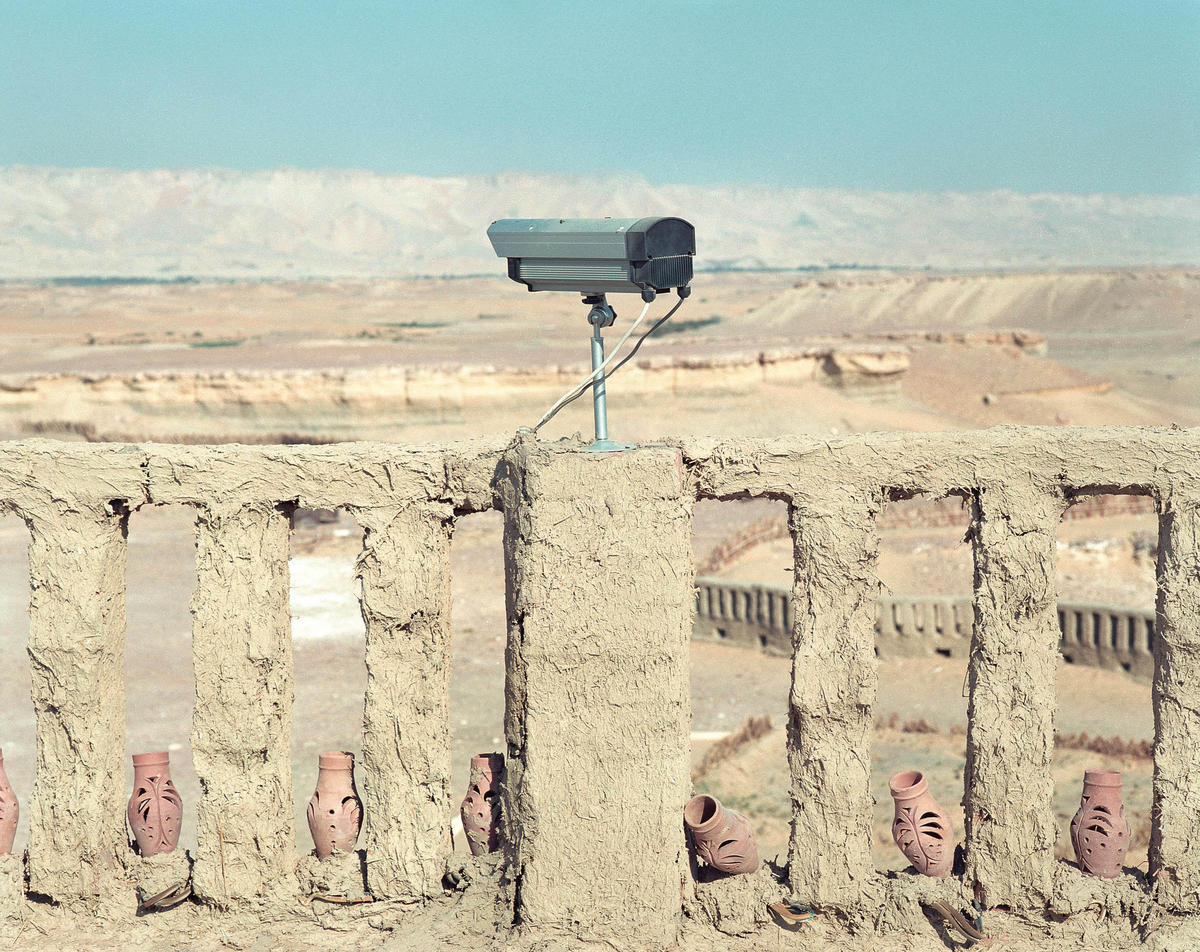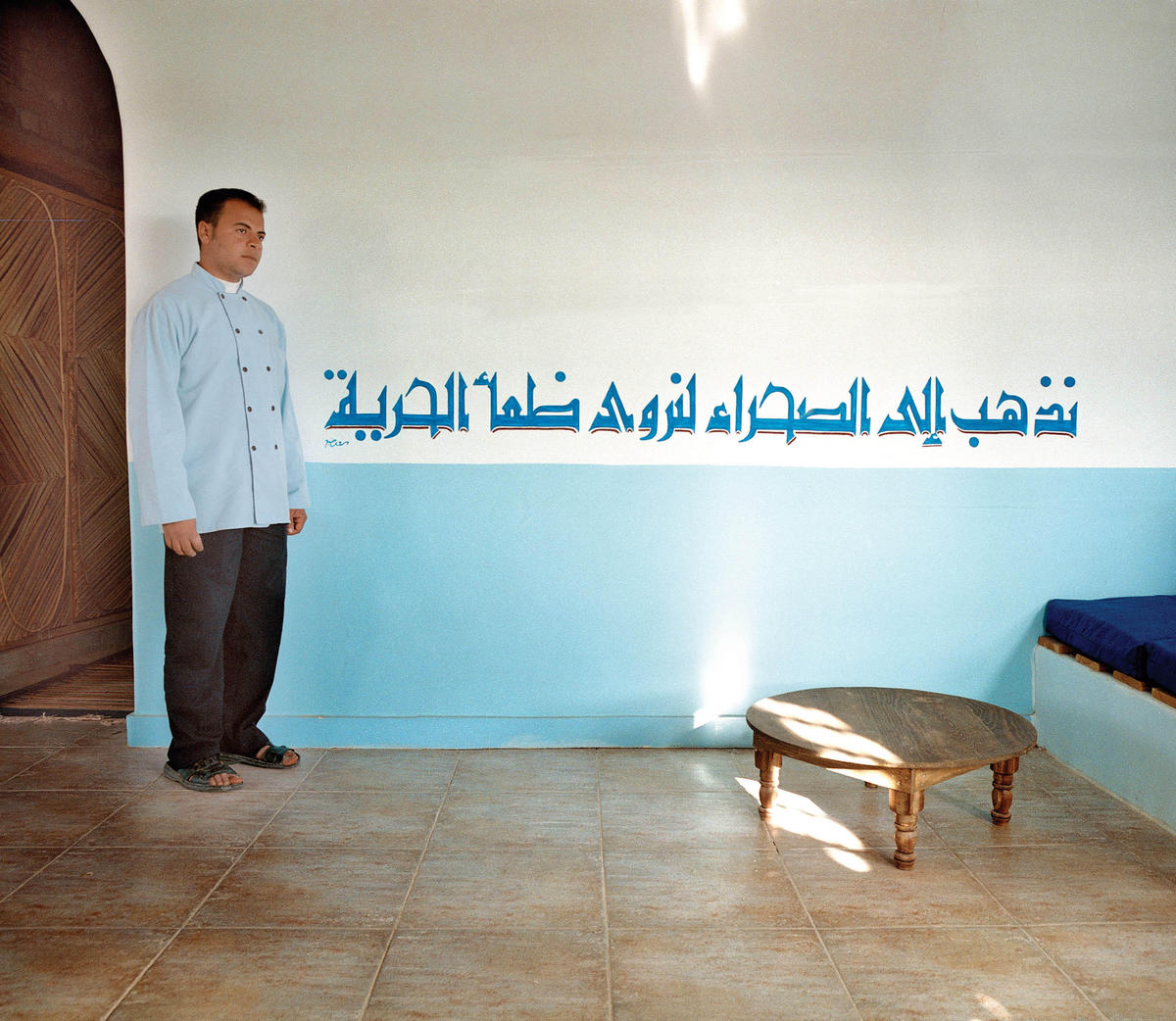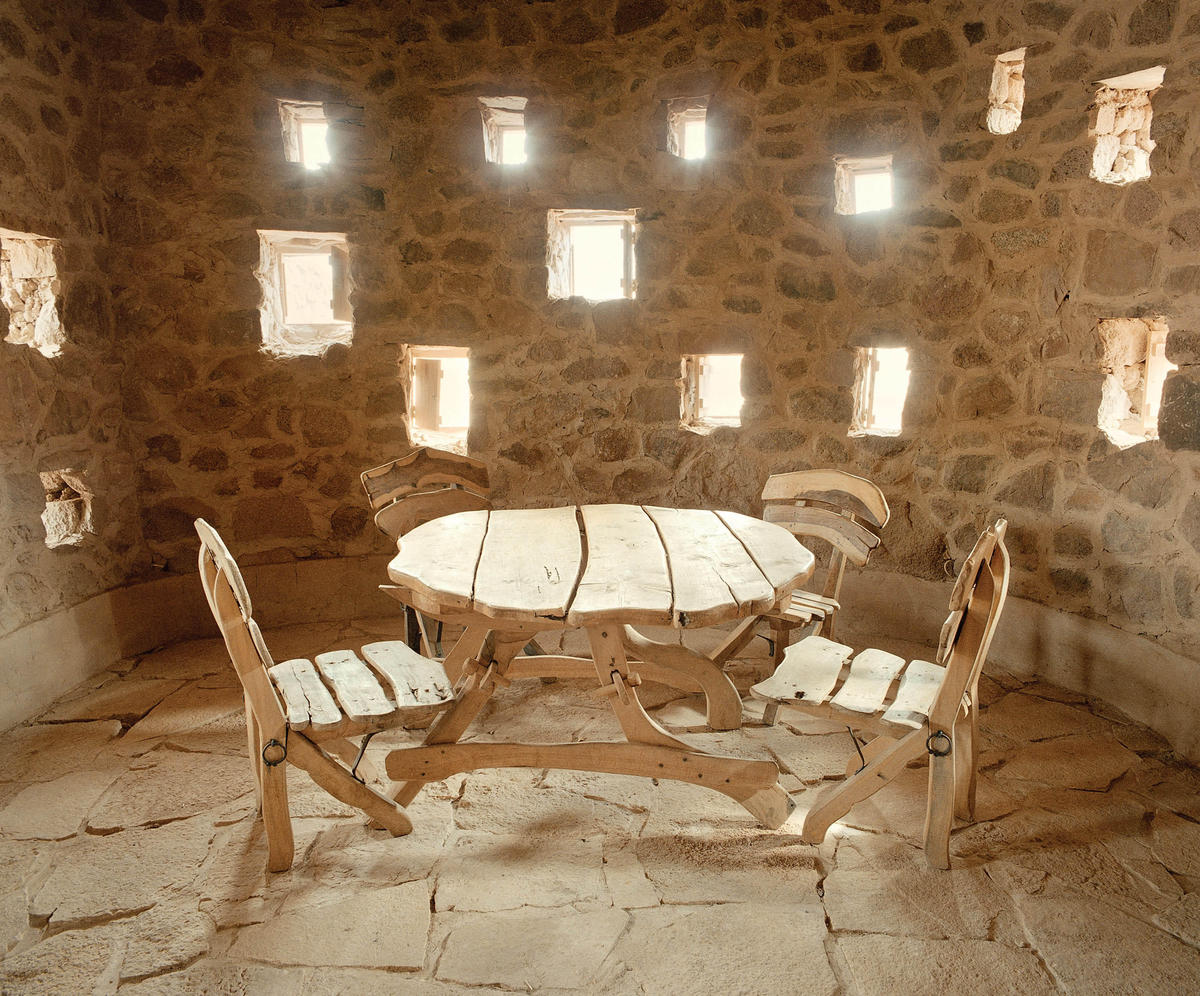
Qasr, Dakhla Oasis, the western desert of Egypt. It’s not the end of the world, but you can get there from here with a 4 x 4 and a knowledgeable guide. The oasis is a tiny patch of green surrounded by rolling yellow dunes — a lifeboat riding the great sand sea.
It was half past nine in the morning and we were finishing a large breakfast of boiled eggs and unleavened local bread, tea and some white cheese. We were eating oranges from the trees around us. Sitting on his haunches in the grass, his white gallebeya stretched across his knees, Abdel Hamid was talking about the days when there were no paved roads in the oases and gasoline was brought in by the jerry can. He was back on his theme of choice: how things were better back then.
“Electricity came in the 80s, and television came after that,” he paused and pointed around at the garden. “People still don’t use chemicals in the gardens. They don’t like it.”
The resident manager of a new ecolodge perched on a cliff overlooking the old town, Abdel Hamid also runs a recycling program in the town itself. Every Thursday he gets the kids together and shows them how to collect, separate and package the waste thrown into the street for shipping to Cairo — 850 kilometers away — for recycling and sale.
“It’s hard to change the system,” he sighed. “It’s hard to change because it’s all about money.” After breakfast we went for a walk. We sniffed olives and ate tangerines. Abdel Hamid showed us the traditional wooden lock on his garden gate, which has a unique toothed key that can be removed. He then took us to the neighbor’s garden so that we could peer over a mud-brick wall at a little flock of sheep and visit some cows.
“That’s not eco,” Abdel Hamid laughed as he shot the steel bolt on the door of the cow pen. “But that’s eco,” he added a moment later, fiddling with the wooden variant to get us back into his garden.
To get a little perspective on the goings on in Abdel Hamid’s orchard that morning, it’s necessary to go back a little — back to the nineteenth century — which, at least for Egypt, was when the era of exploration began to give way to the era of the tourist.
A brief history of Egyptian tourism
Until sometime in the early nineteenth century, say 1830 or 1840, tourists — at least not the consumers of mass tourism that we now associate with the term — had not yet been invented. Back then, traveling was beneficial, and not just to your tan: it broadened the mind and it served mankind (primarily the “us” portion of it) by furthering the noble pursuit of science.
Early guidebooks for Egypt contained hints of this, including reading lists that covered the likes of Herodotus and a list of questions in need of investigation and sites to be excavated. I.G. Wilkonsin’s Modern Egypt and Thebes, for example, recommended that travelers bring along their own own sextant, barometer and measuring tape. It was only later, as travel became more accessible to the wage earning classes, that the didactics disappeared and books were structured around itineraries (rather than subjects), leaving travel less arduous and cheaper rather than more enlightening for the individual and beneficial to the goals of imperial science.
Fast-forward a century and a half. Mass tourism is now operating under the sign of hedonism: a bikini-clad bust on a field of tan with twin crossed martini glasses, a little straw umbrella and a cherry on top.
Flying tourists to resorts developed like row houses by the sea — each a unique, sculpted little world of its own, where one could be fleeced of dollars and euros — was also intended to be “beneficial,” albeit not quite in the same way that Wilkinson had envisioned. In fact, the World Bank among other institutions has historically pushed this variety of tourism, encouraging “underdeveloped” countries like Egypt to invest in tourism as a way of using the self-indulgent profligacy of the western consumer to suck cash out of rich countries and funnel it into poor ones. Problem was that much of the money ended up back in Switzerland (“leakage,” some call it; “crony capitalism” say others), and the natural environment, on which the industry was originally founded, was devastated. It is hard now for a tourist in the Red Sea city of Sharm El Sheikh to catch a glimpse of the pristine seaside landscape and Bedouin community that the sprawl of hastily thrown up cut-rate “five-star” resorts have obliterated.
Mass tourism in Egypt, in other words, is destroying its resource base. And it is doing so at just the time when biodiversity, at least in Europe and North America — the home of many a (relatively) wealthy tourist — has come out of the cafe and into the boardroom. “Sustainability reporting,” says international accounting firm KPMG, “is becoming mainstream business.”

The new universalism
A new kind of scientific universalism, quite different in some ways from its nineteenth century precursor, is being asserted. Biodiversity, rather than science, is its watchword and sustainability, not progress, its rubric.
Backed by hundreds of millions of foreign-aid dollars in the form of European Union and USAID programs, this new universalism is being helped along by a small but significant percentage of tourists. Estimates are that 10 to 15 percent of the annual 700 million of us who are tourists for a week or two every year may be counted as “ecotourists.” These ecotourists, according to Egyptian desk clerks and tour guides, are more often French or German than any other nationality, generally a little older than those who head for the beaches; perhaps most importantly, they are after experience — experience far from the hot sand and cold drink formula that the resorts are peddling.
Ecotourism plays out the old distinction between the vulgarities of mass consumption and the refinements of quality consumption. Propelled by the new imperatives of anti-consumption, ecotourism sometimes takes this distinction to its extreme, selling the experience of paying as much as possible for as little as possible.
At Adrere Amellal ecolodge in Siwa, tourists shell out $400 (US) a night for rooms in a facility with no electricity and palm frond beds. At the other end of the scale, visitors to Basata (Arabic for “simplicity”) pay ten euro to sleep in a grass hut on the beach by the Red Sea and eat food from a communal kitchen.
Sherif Ghamrway, who has been running Basata for twenty years, is happy to discuss the formula. “From our perspective, one ecotourist equals 30 tour tourists: they use less water, less electricity, less facilities — less of everything — but they will pay three times as much.”
Less of everything except for one: the sense that they are experiencing something unique, something particular to the time and the place. Talking about the business model that means, according to him, a better return on his capital than the Hyatt, the Cairo-born Sherif is wearing a long white gallebeya and headdress borrowed from the desert Bedouin. He wears the rig to serve dinner.
This deliberate over-layering of culture with ecology is explicitly part of the ecotourism agenda as laid out by a number of organizations, from the World Tourism Organization to the Ecotourism Committee of the Egyptian Chamber of Tourism: the need to integrate local culture with the eco-facility is one of the few things that almost everyone in the industry agrees on.
Sitting in a Cairo cafe, Ahmed Moussa, operator of the Swiss-Egyptian Desert Ecolodge in Dakhla and Abdel Hamid’s boss, puts it this way: “People would like to see different cultures, different people. For me, if I go to England, France, Spain, it’s all the same. Tourists want to see, and will pay to see, different people, different cultures.”
Perhaps it should not be surprising, given the popularity of “reality TV,” that we now have reality tourism. The fact that the particularism is genuine cannot disguise the fact that it is carefully constructed and edited.
Sitting on a flat rock outside the kitchen at the Al Karm Ecolodge at Wadi Tarfa near St. Catherines, Jamil Atiya, who runs the lodge, explains that it was constructed along traditional lines.
“The only difference we made is that the doors are higher,” he puts his hand out flat, two feet above the ground. “In the old houses you have to bend over to get in the door.” He starts to laugh. Nobody builds in the traditional way anymore, he explains, because it’s too expensive. Later, walking up to an abandoned village on which the lodge is modeled, he takes us past a rock trap of the kind the Bedouin used to wipe out many of the Sinai’s hyenas, wolves and leopards. Particularism is at the same time the hallmark of a tourist experience that relies on the richness of the experience rather than the thread count of the sheets (thus harking back to the pre-tourist centuries) and a manner of countering the universalizing power of the scientific/economic imperative behind sustainability. It’s what the tourist pays for, and it’s the means by which locals can turn globals to their own ends, negotiating a limited degree of freedom to pursue their own agendas, a pursuit that can sometimes take them off at peculiar angles.
Case in point. At 5:25 on the evening before we had breakfast in his garden, Abdel Hamid had me taking notes in the dark. We were standing on the edge of the desert and he, enthused, was pointing here and waving over there, talking about his new project, his words pouring out into the crepuscule.
“Two cows, two camels, two chickens, two bears,” he counted them off on his fingers, slapping his right hand down on his left like Noah trying to get everyone on board before the rain started. “two geese, two foxes, two wolves, two horses — every kind of animal from Dakhla will be there.”
By the time he got done, his white gallebeya, glinting in the white light from the nearby Bir Gebel tea garden, was about all I could see. I was writing by feel.
Bir Gebel is a hot spring. We had come down to soak in the sulphorous waters at sunset but found them occupied, so our host took to explaining his next project: a zoo that would sit like a chicken wire ark at the edge of the world’s biggest beach. Geese, wolves, chickens and cows all milling about in their pairs. The mind boggles at the likely reaction of German and French ecotourists to the sight, but to Abdel Hamid it all seems very natural.
